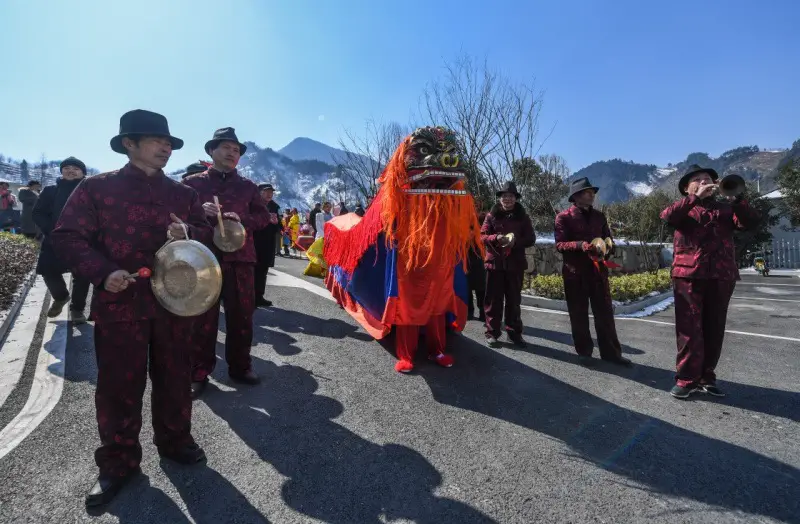The Red-Haired Lion, a name well-known in the vicinity of Fenghuangshan at the foot of the Phoenix Mountain in Tuan Kou Town, Lin’an City, is more commonly referred to as the “Transforming Lion.” Every festive occasion or joyous event in the village calls for the performance of this Red-Haired Lion dance troupe, bringing an unparalleled spectacle to the villagers.
Origin of the Red-Haired Lion
The Red-Haired Lion, a legendary folk lion dance activity, originated during the Xianfeng period of the Qing Dynasty and has endured more than 150 years of vicissitudes. It continues to thrive on the stage at the foot of Phoenix Mountain in Fenghuang Village, Tuan Kou Town, Lin’an City. Whenever this history is mentioned, local elderly people cannot help but reminisce about those turbulent times.
It is said that during the Qing Dynasty, the Taiping Army (commonly referred to as the “Long Hair” by the elderly) led by Hong Xiuquan and Yang Xiuqing was stationed in Badu Village, which is now the location of the Tuan Kou Town government, for three years. During those three years, chaos reigned, compounded by frequent natural disasters, resulting in heavy casualties among the villagers. The Zhu Clan Ancestral Hall at the foot of Phoenix Mountain was also burned down in the flames of war, forcing the villagers to flee their homes and seek refuge elsewhere. This period of history became an eternal pain in the hearts of the people of Fenghuang Village.

However, when the displaced villagers returned to their homeland, they received a mysterious revelation. According to legend, there was a “Lion God” living in a cave on Phoenix Mountain, which provided guidance to the villagers: only by building the Xuan Emperor Temple at the village entrance and inviting the Lion God down the mountain could Fengshan be protected. In order to ensure the peace of their homeland, the ancestors of Fenghuang Mountain decisively decided to follow the instructions of the Lion God.
They then invited boxing instructor Chen Zhongzong (also known as Wu Xiucai) from Fenshui, Chun’an, and established a martial arts academy in the village to teach martial arts. At the same time, the lion dance activity of the Red-Haired Lion gradually spread to the village and its surrounding areas. Villagers made majestic lion heads and lion bodies from red lion skins, forming dance lion teams. Accompanied by the beat of gongs and drums, they danced with the lion bodies, changing various formations and movements, showcasing the majesty and magic of the Red-Haired Lion.
To commemorate this history and promote the lion dance activity, villagers specifically designated the period from the end of the twelfth lunar month to the eighteenth day of the first lunar month as the time for the appearance of the “Red-Haired Lion.” During this period, whether celebrating a bumper harvest, offering sacrifices to the gods, or holding other festive events, the presence of the Red-Haired Lion was indispensable. It has become an integral part of local festive activities, shining brightly alongside joyous celebrations.
The process of the Red-Haired Lion’s lion dance is full of changes and creativity. Dancers, clad in red lion skins, leap, roll, and move about in rhythm to the music, displaying various lion poses. As the shape of the lion changes in the course of the dance, the Red-Haired Lion is also known as the “Transforming Lion.” This variation is not only reflected in the lion dance movements but also in the organization and performance styles of the lion dance teams. Each lion dance team has its own unique style and characteristics, making the performance of the Red-Haired Lion even more colorful.
As time has passed, the Red-Haired Lion has become a cultural symbol of Fenghuang Village and a treasure of folk art. It not only embodies the villagers’ longing for and pursuit of a better life but also inherits the outstanding traditional culture and folk art of the Chinese nation. Whenever the Red-Haired Lion dances in the village, it attracts countless spectators. They are drawn by the majesty and magic of the Red-Haired Lion and infected by the dancers’ superb skills and enthusiasm.
Today, the Red-Haired Lion is not just a folk lion dance activity but also a continuation of culture and an embodiment of national spirit. It will continue to be passed down in Fenghuang Village and its surrounding areas, bringing joy and auspiciousness to the villagers and adding a unique charm to the traditional culture of the Chinese nation.
